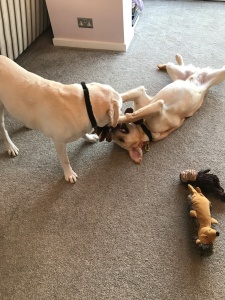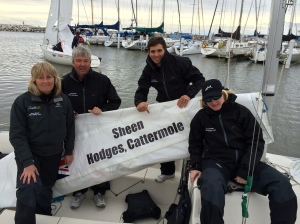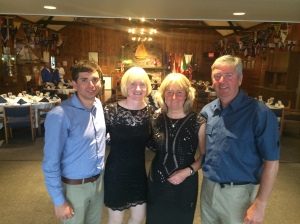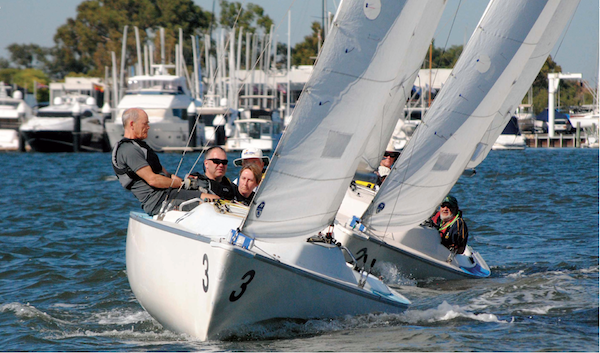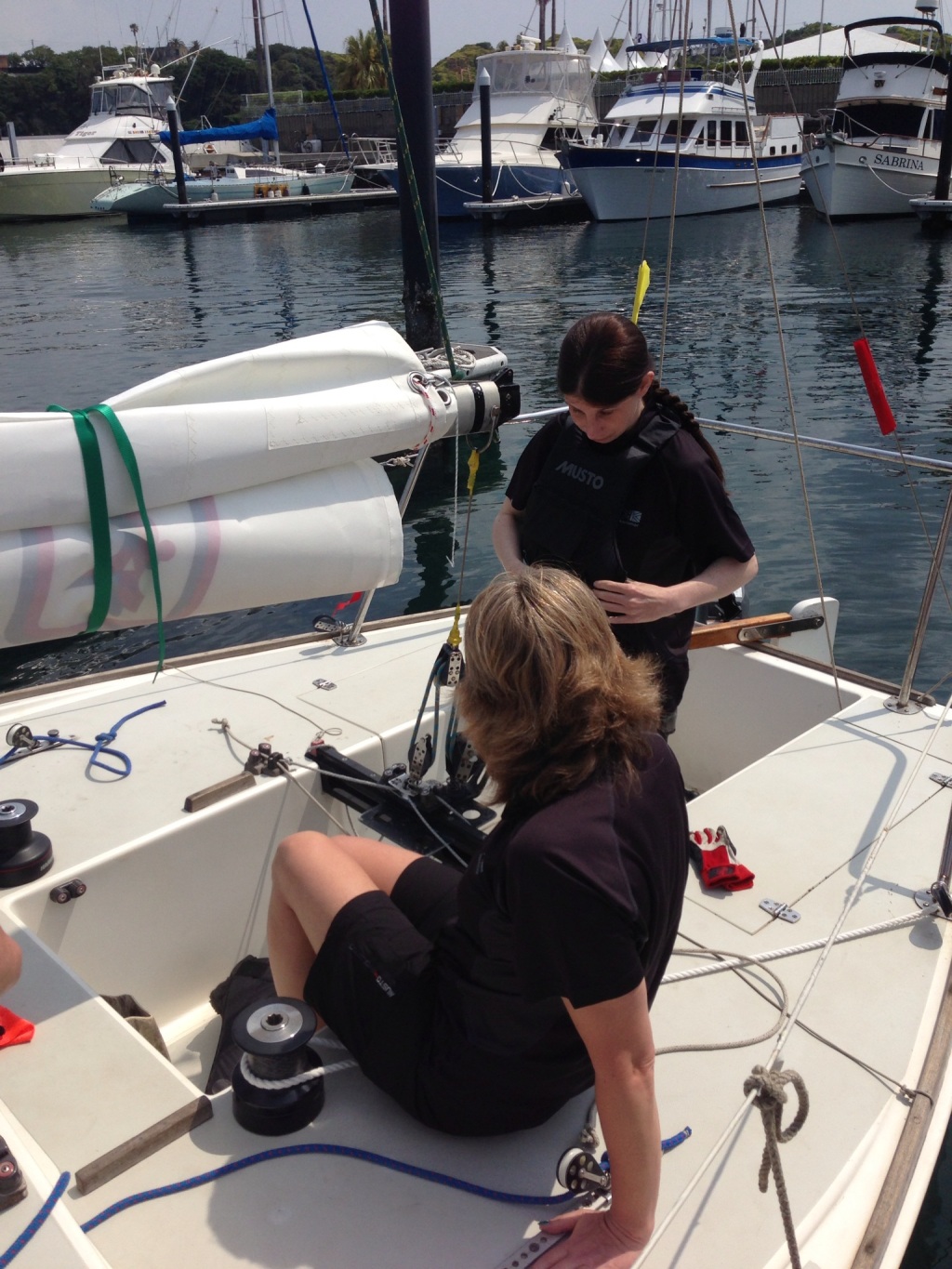The joys of Guide Dog training with your fith dog
Pre Class. Is it love?
Houston arrived for two days prior to us going on class together. A big sigh of relief to discover new and retired dogs get on. Playing tug together. Old timer Zeke dragging the new Houston lying on his back paws in the air tugger in his mouth and Zeke dragging him across the carpet. Oh well, it saved me having to groom him. Later on, they are both lying side by side, Houston’s head on Zeke’s back.
Day one of training. Your guide dog hangs on your every word!
Tried out the wonderful command “Hup sit”, worked really well, I put my hand down to check that he was now sitting rather than lying, to discover he was now lying on his back with all four paws up in the air. When we went next door to Steve and his German Shepherd Waffles room. I stuck my head around the door, to see if Steve was ready, then went on. I hadn’t realised Houston had also sneaked his head around the door and snagged one of Waffle’s toys. Houston did have the grace to drop it straight outside Waffle’s door for Steve and waffle to stand on when walking out of their room.
Houston is the first of my guide dogs who hasn’t jumped up onto my bed when left in the hotel bedroom on his own at meal times. However he does seem to think my bed is a double in order to give space for him to join me on, at night once I have gone to bed.
Mornings. Oh the joy of a youngster who thinks five o’clock is for playing and working out how best to sneak back onto your bed again. No must only have referred to no, I don’t want to share my bed with you at night, but clearly I will be happy for you to come and join me in the bed in the early morning.
My other dogs had the grace to look guilty when I told them off and kicked them off the bed. Houston instead, try’s to dig his metaphorical heals in. becomes a very heavy lump that is impossible to drag off the bed and Oh Yes clearly deaf. No longer able to hear any commands. Once you have got the teenager off your bed you get the “Its not fare” expression as he flops dejectedly on his own, very plush holofilled bed.
Day two: So, how many toys can a lab retriever hold in his mouth at once?
Apparently four is the record, always at least two. I am not sure it is “One for me and one for you”, but he is pretty generous and willing to share.
Day Tree: Relax
Then at last come tea time, the leggy teenager is back again. This time flaked out and exhausted and needing to recharge his battery. At least curled up on my feet with a toy wedged under his nose, I know where he is and that he isn’t getting into any more trouble.
Day four. Can you multi-task with your new guide dog?
Best not. This morning demonstrated that you need all your wits about you when first on training with your new dog. Trying to make phone calls, check your emails, make sure you have the right gear for the days training, while rushing down slightly late to meet up with everyone else for the morning briefing, is a receipt for disaster.
Your new guide dog senses that he does not have your full attention. You might not have realised that he is slightly taller than your just retired dog and he can stretch his neck round placing his chin on the table inches from food. Or having joined the group, grabbed the available chair failed to invest the time to persuade him to laying down properly, you are now distracted, trying to listen to the pearls of wisdom from your trainer explaining the activities and training programme for the day, while using the other side of your brain to try and work out how to stop the new boy from stretching making himself as long as possible in order to reach the dog lying down within three feet of him. You successfully intercept that maneuverer of his, but miss the question directed to you by your trainer. You refocus on the trainer and his question and the boy senses this and does a dummy stretch and roll and makes it to the guide dog previously lying placidly on his other side. Again it is amazing what a heavy immovable lump a guide dog can become when you want him to tuck in close to you and he wants to continue being a nuisance with the pretty black Labrador on the other side of the table. You have now failed twice; either to follow your instructors talk or to control your guide dog adequately. I will try to do better.
Day five. Can a two year old spell?
It seems Houston can get as far as “GU”. But is confused between Guide dog and Guard dog. Barking at a gentleman in the bar for just staring at him. His trainer is suitably unimpressed. But does inform me he is on “special offer”. Apparently, he is a “two for one”, and I am lucky to have both a guide dog and guard dog.
Day six. Is it Green for go, or red for stop?
Houston can really step it out when given the chance on a decent walk. He can also be very frustrating when doing what he considers is a “pointless” exercise such as off curb maneuverers. I really do need to learn how to manage a retriever as opposed to my four previous Labradors. Cleary the on off buttons are in a different place.
Day seven. Traffic, what’s that all about?
Your dog is taught not to step out in front of a moving car. A particularly difficult exercise as they have to disobey your command to go forward. Houston was perfect, but decided in Houston style, to take it a stage further. He had identified the nice blue car which was stalking us, so Houston kept trying to let me know where the car was and thought it would be a better game if we just went to the car, rather than waited for the car to come to us. An intelligent clown and you can kind-of see his logic.
Day Eight. So that’s where the phrase came from!
Houston has a besmirched reputation for his recall, but we have cracked it. Fish treats work every time. So, that’s, where the phrase “It works a treat” comes from. One fish treat and I am now Houston’s best buddy.
Day nine. How many dogs can you meet during just one walk?
An amazing walk with Houston through Dawlish. Ducks, geese and dogs galore. Nothing daunted Houston and lots of opportunity to let him know that I decide where we go, not him, “No I don’t want to go into the pet shop and, yes I know there is yet another dog there”. Walking back up through the park along the river side, the trainers held their breath as an off lead Labrador , leapt across in front of us and dived into the river, Houston thought about it, the trainers hovered ready to intercept, but no at the last second Houston thought better of joining the recalcitrant Labrador, instead continuing on with our journey with his head held high.
Day nine. The joys of bin day!
It’s not easy being a guide dog. Now back home and trying out our first home walk. None of us remembered it was bin day. The pavements had sprouted green wheelie bins . Houston took it in his stride, treating them like a slalom course. However it was the even more challenging second home walk, meandering through the maze of narrow streets of terraced fishermen cottages with no pavements, which really caught Houston’s interest and problem solving skills. Far more interesting than boring wide straight pavements. However after his first day working in Brixham, the boy wasn’t too tired and later found the energy to race around in circles in the park in the early spring sunshine.
Day Eleven. How much space can a dog take up?
A moving dog jangling the bells on his collar is easy to find, , a pooched pup stretched out on his side now oblivious to the world, is less easy to locate. Not realising my husband was curiously watching, I attempted to manoeuvre around my flaked out new guide dog sprawled across the floor. I knocked into his head with my foot, then attempted to step wide around him but still managed to step onto his tail, not that he moved a muscle with either assault. “Yes”, observed Ivan “Good to know he has two ends, ”. Clearly amused that I had just managed in one go, to step on both nose and tail of my dog.
Day twelve. Boys and their toys.
Awoken at six this morning by Houston repeatedly and continuously squeaking his favourite noisiest toy. I must remember to frisk him more thoroughly for loud toys when he climbs the stairs to come to bed. On the other hand, I wouldn’t put it past him not to have during the day, secreted a noisy toy hidden under the cushion of his bed, just for the purpose of being our morning alarm clock.
Today Houston and I did our first walk without his trainer. The roads around where I live are not easy, yet Houston was great. He coped with the sections without pavements, taking me to the correct crossing points. He was suitably cautious on the narrow pavement while approaching the large gentleman with his equally large dog. The goofy boy can put his sensible head on when he needs to, areal confidence boost.
Day Thirteen. Just like the first day back at school.
Day Fourteen. How do you keep the new boy entertained?
Our first route on our own to a meeting. Houston was so good no one even notice it was a different dog!
Houston goes from inquisitive new boy to crashed out teenager in a matter of seconds, but while in play mode tugger toys and noisy play growling seems to be a favourite. For those long hours at work, we invested in a level one intelligent toy for dogs. Two layers which can be spun by the clever dog to expose hidden treats. It took us longer to choose the new toy in the shop, than it took Houston to find and remove all eight treats. I would guess it took him only fifty-five seconds. It’s now back to the shop to find a level three toy.


Week Three:
A leap in the dark.
Houston and I are now learning the route from town to home via the sea front. My concerned trainer feels it necessary to point out to me that I am walking beside a deep drop into the harbour. I cheerfully let him know that it won’t be quite such a long drop at high tide. I am not convinced that reassured him.
Dog distraction?
You learn to control your new dog even when it is distracted by other dogs. However no one mentioned before the issue of guide dog instructor distraction, as she stops focusing on your training walk with your new dog and becomes fascinated by the three seals playing in the harbour. I am sure that the trainer would have mentioned it, if Houston had decided to walk me down the slip way, rather than bear left to high ground. Maybe I should always work Houston in Wellington boots just in case he has a sense of humour.
Week Four:
Where is my shoe?
Back to frisking the dog. I do check Houston for toys when I let him out into the garden, but clearly not well enough, when friends ask if there is a reason for my favourite pink trainer to be in the middle of the lawn.
“The Great Escape”
Last night, humming the theme tune to the “Great Escape”, Houston burrowed his way under the new fencing to emerge in the holiday camp below us. Luckily, due to an eight foot bank and a dog scared of heights, Houston was then stuck until rescued by Ivan climbing over the wall to push him back under the fence. Each of my previous four guide dogs have all escaped at some time, For Houston, it was just a question of “When and where”. Now where did we put the spare wood, hammer and nails?



